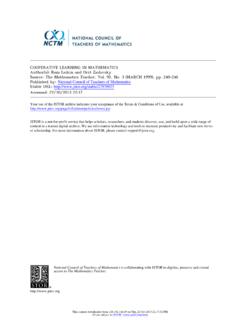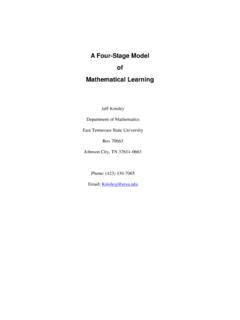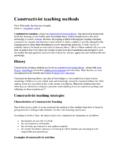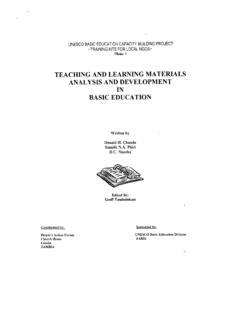Transcription of What is Mathematics - Discretization
1 teaching and learning what is Mathematics G unter M. Ziegler and Andreas Loos Abstract. what is Mathematics ? [with a question mark!] is the title of a famous bookby Courant and Robbins, first published in 1941, which does not answer the question is, however, essential: The public image of the subject (of the science,and of the profession) is not only relevant for the support and funding it can get, butit is also crucial for the talent it manages to attract and thus ultimately determineswhat Mathematics can achieve, as a science, as a part of human culture, but also as asubstantial component of economy and this lecture we thus discuss the image of Mathematics (where image might be taken literally!), sketch a multi-facetted answer to the question what is Mathematics ?, stress the importance of learning what is Mathematics in view of Klein s doublediscontinuity in Mathematics teacher education, present the Panorama project as our response to this challenge, stress the importance oftelling storiesin addition toteachingmathematics, and finally suggest that the Mathematics curricula at schools and at universities should correspond-ingly have space and time for at least three different subjects called Subject Classification (2010).
2 Primary 97D30; Secondary 00A05,01A80, what is Mathematics ? ; the image/the images of Mathematics ; Klein s double discontinuity ; teaching Mathematics ; telling stories about Mathematics ; the Panorama of Mathematics what is Mathematics ?Defining toWikipediain English, in the March 2014version, the answer to what is Mathematics ? isMathematicsis the abstract study of topics such as quantity (numbers),[2]structure,[3]space,[2]and change.[4][5][6]There is a range of views among The authors work has received funding from the European Research Council under theEuropean Union s Seventh Framework Programme (FP7/2007-2013)/ERC grant agreementno. 247029, the DFG Research CenterMatheon, and the the DFG Collaborative Research CenterTRR 109 Discretization in Geometry and Dynamics 2G unter M. Ziegler and Andreas Loosmathematicians and philosophers as to the exact scope and definition ofmathematics.
3 [7][8]Mathematicians seek out patterns[9][10]and use them to formulate new con-jectures. Mathematicians resolve the truth or falsity of conjectures by math-ematical proof. When mathematical structures are good models of realphenomena, then mathematical reasoning can provide insight or predictionsabout nature. Through the use of abstraction and logic, Mathematics de-veloped from counting, calculation, measurement, and the systematic studyof the shapes and motions of physical objects. Practical Mathematics hasbeen a human activity for as far back as written records exist. The researchrequired to solve mathematical problems can take years or even centuries ofsustained of this is entirely wrong, but it is also not satisfactory. Let us just point outthat the fact that there is no agreement about the definition of Mathematics , givenas part of a definition of Mathematics , puts us into logical difficulties that mighthave made G odel answer given byWikipediain the current German version, reads (in ourtranslation): Mathematics [.]
4 ] is a science that developed from the investigation ofgeometric figures and the computing with numbers. Formathematics, thereis no commonly accepted definition; today it is usually described as a sciencethat investigates abstract structures that it created itself by logical definitionsusing logic for their properties and is much worse, as it portrays Mathematics as a subject without any contactto, or interest from, a real borders of Mathematics stand-alone ? Could it bedefined without reference to neighboring subjects, such as physics (which doesappear in the EnglishWikipediadescription)? Indeed, one possibility to char-acterize Mathematics describes the borders/boundaries that separate it from itsneighbors. Even humorous versions of such distinguishing statements such as Mathematics is the part of physics where the experiments are cheap. Mathematics is the part of philosophy where (some) statements are true without debate or discussion.
5 Mathematics is computer science without electricity. (So Computer scienceis Mathematics with electricity. )contain a lot of truth and possibly tell us a lot of characteristics of our of these is, of course, completely true or completely false, but they presentopportunities for toWikipedia, the same version, the answer to Who is Mathematics should beMathematics, also known asAllah Mathematics , (born:Ronald MauriceBean[1]) is a hip hop producer and DJ for the Wu-Tang Clan and its solo andaffiliate is not the Mathematics we deal with and learning what is Mathematics 3 what we do in could also try to define Mathematics by what we do in Mathematics : This is much more diverse and much more inter-esting than theWikipediadescriptions! Could/should we describe mathematicsnot only as a research discipline and as a subject taught and learned at school,but also as a playground for pupils, amateurs, and professionals, as a subject thatpresents challenges (not only for pupils, but also for professionals as well as foramateurs), as an arena for competitions, as a source of problems, small and large,including some of the hardest problems that science has to offer, at all levels fromelementary school to the millennium problems [4] [21]?
6 what we teach in Mathematics bureaucrats might (andprobably should) believe that the question what is Mathematics ? is answeredby high school curricula. But what answers do these give?This takes us back to the nineteenth century controversies about what mathe-matics should be taught at school and at the Universities. In the German versionthis was a fierce debate. On the one side it saw the classical educational ideal asformulated by Wilhelm von Humboldt (who was involved in the concept for andthe foundation 1806 of the Berlin University, now named Humboldt Universit at,and to a certain amount shaped the modern concept of a university); here mathe-matics had a central role, but this was the classical Greek Mathematics , startingfrom Euclid s axiomatic development of geometry, the theory of conics, and thealgebra of solving polynomial equations not only as cultural heritage, but also asa training arena for logical thinking and problem solving.
7 On the other side ofthe fight were the proponents of Realbildung :Realgymnasienand the technicaluniversities that were started at that time tried to teach what was needed in com-merce and industry: calculation and accounting, as well as the Mathematics thatcould be useful for mechanical and electrical engineering second rate educationin the view of the classical German nineteenth century debate rests on an unnatural separation into the classi-cal, pure Mathematics , and the useful, applied Mathematics ; a division that shouldhave been overcome a long time ago (perhaps since the times of Archimedes), as itis unnatural as a classification tool and it is also a major obstacle to progress bothin theory and in practice. Nevertheless the division into classical and current material might be useful in discussing curriculum contents and the question forwhat purpose it should be taught; see our discussion in Section Courant Robbins title of the present paper is, of course,borrowed from the famous and very successful 1941 book by Richard Courant andHerbert Robbins [3].
8 However, this title is a question what is Courant andRobbins answer? Indeed, the book does not give an explicit definition of what isMathematics, but the reader is supposed to get an idea from the presentation of adiverse collection of mathematical investigations. Mathematics is much bigger andmuch more diverse than the picture given by the Courant Robbins presentation in this section was also meant to demonstrate that we need amulti-facetted picture of Mathematics : One answer is not enough, we need unter M. Ziegler and Andreas Loos2. Why Should we Care?The question what is Mathematics ? probably does not need to be answered tomotivatewhymathematics should be taught, as long as we agree that mathematicsis , a one-sided answer to the question leads to one-sided concepts ofwhatmathematics should be the same time a one-dimensional picture of what is Mathematics will failto motivate kids at school to do Mathematics , it will fail to motivate enough pupilsto study Mathematics , or even to think about Mathematics studies as a possiblecareer choice, and it will fail to motivate the right students to go into mathematicsstudies, or into Mathematics teaching .
9 If the answer to the question what isMathematics , or the implicit answer given by the public/prevailingimageof thesubject is not attractive, then it will be very difficult to motivatewhymathematicsshould be learned and it will lead to the wrong offers and the wrong choices astowhatmathematics should be , would anyone consider a science that studies abstract structuresthatit created itself(see the GermanWikipediadefinition quoted above) interesting?Could it be relevant? If this is what Mathematics is, why would or should anyonewant to study this, get into this for a career? Could it be interesting and meaningfuland satisfying to teach this?Also in view of the diversity of the students expectations and talents, webelieve that one answer is plainly not enough. Some students might be motivatedto learn Mathematics because it is beautiful, because it is so logical, because itis sometimes surprising.
10 Or because it is part of our cultural heritage. Othersmight be motivated, and not deterred, by the fact that Mathematics is might be motivated by the fact that Mathematics is useful, it is needed in everyday life, for technology and commerce, etc. But indeed, it is not true that the same Mathematics that is needed in everyday life, for university studies, orin commerce and industry. To other students, the motivation that it is useful or it is needed will not be sufficient. All these motivations are valid, and good and it is also totally valid and acceptable that no single one of these possibletypes of arguments will reach and motivateallthese do so many pupils and students fail in Mathematics , both at school andat universities? There are certainly many reasons, but we believe that motivationis a key factor. Mathematicsishard. It is abstract (that is, most of it is notdirectly connected to everyday-life experiences).









